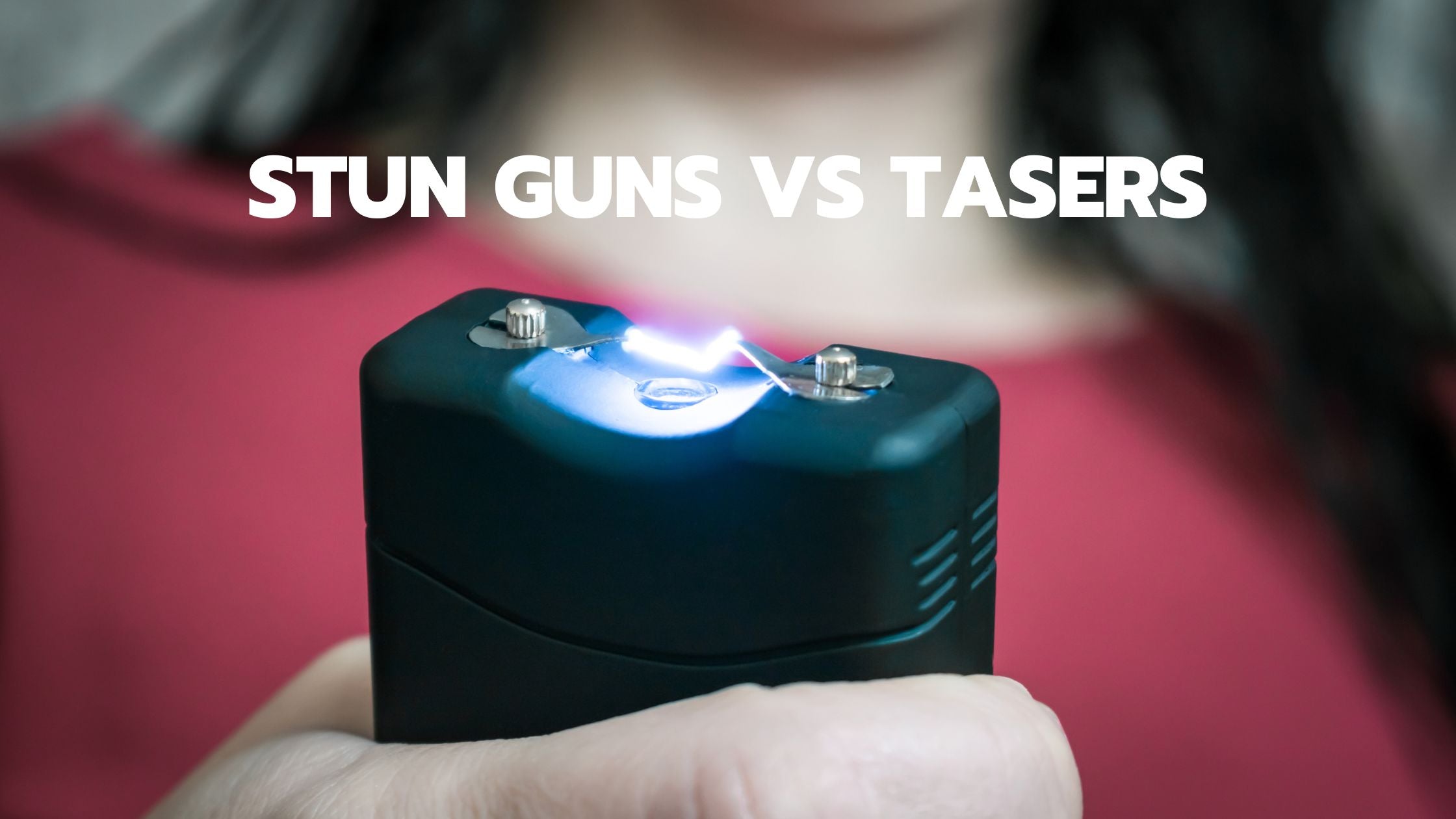Personal safety is a fundamental concern for individuals in today's world. Whether it's walking alone at night or navigating unfamiliar surroundings, many people seek ways to protect themselves from potential threats. In recent years, the popularity of non-lethal self-defense weapons has soared, providing individuals with a sense of security without resorting to lethal force.
Among the array of self-defense options available, stun guns and Tasers have gained significant attention. These electroshock weapons offer an alternative to traditional firearms and provide individuals with a means to defend themselves effectively. However, it is crucial to understand the key differences between stun guns and Tasers to make an informed decision when selecting a self-defense tool.
In this blog post, we will delve into the intricacies of stun guns and Tasers, uncovering their unique characteristics and exploring how they function. By the end of this discussion, you will have a comprehensive understanding of these non-lethal weapons, enabling you to make an educated choice based on your personal safety needs and legal considerations. So, let's embark on this enlightening journey to distinguish between stun guns and Tasers and empower ourselves with the knowledge required for effective self-defense.
Stun Guns
Definition and Functionality:
Stun guns are handheld, non-lethal self-defense weapons that are designed to immobilize and incapacitate an attacker through the application of an electric shock. They are compact and easy to carry, making them a popular choice for personal safety.
Stun guns operate by delivering a high-voltage, low-current electric shock to the target upon direct contact. The basic components of a stun gun typically include a power source, such as a rechargeable battery, and a circuit system that boosts the voltage. The electrical charge is delivered through metal prongs or electrodes located at the end of the device.
When the stun gun makes contact with an assailant's body, the electrical current passes through their muscles, causing temporary disruption to the neurological impulses that control muscle movement. This interference can result in pain, muscle contractions, and disorientation, effectively immobilizing the attacker and providing an opportunity for escape.
Effects and Limitations:
Stun guns can have several effects on the human body. The electric shock can cause pain, muscle spasms, and temporary paralysis, which can make it difficult for the attacker to continue their assault. However, it is important to note that stun guns primarily affect the muscles and nerves, and their effectiveness may vary depending on factors such as the duration of contact and the individual's tolerance to pain.
It is also important to consider the limitations of stun guns. While they can provide a valuable means of self-defense, stun guns are typically designed for close-range encounters, requiring direct contact with the attacker's body to be effective. Additionally, certain factors, such as thick clothing or substances that create a barrier between the prongs and the attacker's skin, can reduce the effectiveness of the electric shock.
Legal Considerations:
The legal status of stun guns varies across jurisdictions. In some places, stun guns are considered legal for civilian use, while in others, their possession or use may be restricted or even prohibited. It is crucial to familiarize yourself with the laws and regulations specific to your location before purchasing or using a stun gun.
Certain jurisdictions may impose restrictions on the voltage output, age restrictions, or require a permit or license for stun gun possession. Some locations may also prohibit the use of stun guns in certain public spaces or restrict their use to self-defense purposes only. It is essential to research and understand the legal framework governing stun guns in your area to ensure compliance with the law.
Always remember that while stun guns are designed as non-lethal weapons, their misuse or use inappropriately can still cause harm. Responsible and ethical use, combined with a clear understanding of the legal landscape, is essential to ensure personal safety while complying with local regulations.
Tasers
Definition and Functionality:
Tasers, like stun guns, are non-lethal electroshock weapons designed for self-defense purposes. However, they differ from stun guns in terms of their design and functionality. A Taser is a brand name that has become synonymous with conducted electrical weapons (CEWs) or conducted energy devices (CEDs).
Unlike stun guns, which require direct contact with the target, Tasers have the ability to incapacitate an assailant from a distance. Tasers typically consist of two main components: the handheld device, often called the Taser gun, and cartridges that contain small probes or wires connected to the gun via insulated conductive wires.
When the trigger of a Taser gun is pulled, it releases small probes or wires that are propelled towards the target through compressed air or gas. These probes or wires are designed to attach themselves to the attacker's clothing or skin, creating a circuit. Once the circuit is established, the Taser delivers an electrical discharge through the wires, causing neuromuscular incapacitation.
Effects and Limitations:
The electrical discharge delivered by a Taser affects the target's muscles and nervous system. The pulses of electricity disrupt the communication between the brain and muscles, causing temporary muscle contractions and incapacitation. This can result in loss of balance, pain, and disorientation, rendering the attacker immobile and creating an opportunity for escape.
Tasers have been designed to minimize the risk of serious injury or long-term effects. The electrical pulses are specifically designed to prevent the heart from entering into a dangerous rhythm. However, it is important to note that there have been instances where the use of a Taser has resulted in injury or even death, particularly if the target has pre-existing medical conditions or is subjected to prolonged or repeated shocks.
The effectiveness of a Taser can be influenced by various factors, including the accuracy of the probes' deployment, the target's body size and clothing thickness, and the distance between the Taser and the target. It is essential to understand these limitations and consider them when evaluating the suitability of a Taser for personal self-defense.
Legal Considerations:
The legal status of Tasers, like stun guns, varies across jurisdictions. While some locations permit the civilian use of Tasers, others may impose restrictions or prohibit their possession altogether. It is crucial to research and understand the specific laws and regulations governing Tasers in your area before acquiring or using one.
Similar to stun guns, legal considerations for Tasers may include age restrictions, permits or licenses for possession, restrictions on voltage output, and limitations on their use in certain public spaces. Some jurisdictions may also require training or certification
Key Differences Between Stun Guns and Tasers
When it comes to non-lethal self-defense weapons, stun guns and Tasers are two popular options. While they both serve the purpose of incapacitating attackers, there are several key differences that set them apart. Understanding these distinctions is crucial in choosing the right self-defense tool for your specific needs. Let's explore the primary differences between stun guns and Tasers:
1. Range and Projectile Capability:
One of the fundamental distinctions between stun guns and Tasers is their range and projectile capability. Stun guns require direct contact with the attacker's body to deliver an electric shock. In contrast, Tasers have the ability to immobilize an assailant from a distance. They use propelled wires or probes that attach to the target upon deployment, establishing a circuit through which the electric current is delivered.
The range of a Taser can vary depending on the specific model, but it typically allows for engagement from several feet away. This range advantage provides an added layer of personal safety and the ability to subdue an attacker without being in close proximity.
2. Electrical Mechanisms and Power Sources
Stun guns and Tasers differ in their electrical mechanisms and power sources. Stun guns generate an electrical charge through the use of batteries, typically rechargeable ones. This charge is then delivered directly to the attacker upon contact. Stun guns usually operate at a higher voltage but lower amperage to disable the assailant temporarily without causing significant harm.
On the other hand, Tasers use compressed air or gas to propel the probes or wires towards the target. The electrical current is then delivered through the wires connected to the Taser gun. Tasers typically employ lower voltage but higher amperage, which allows the current to penetrate clothing and overcome resistance.
3. Effectiveness and Incapacitation Potential:
When comparing stun guns and Tasers, their effectiveness and incapacitation potential are essential factors to consider. Stun guns rely on the direct contact of the electrodes with the attacker's body to deliver the electric shock. This contact-based method may require the attacker to be within close proximity for effective use. The immediate effects of a stun gun can include pain, muscle contractions, and disorientation, which can deter further aggression.
Tasers, with their ability to deliver an electrical discharge from a distance, provide a higher level of incapacitation potential. The probes or wires attach to the target, creating a circuit through which the electric current flows. This electrical current disrupts the nervous system and causes temporary muscle contractions, rendering the attacker immobile and creating an opportunity to escape.
4. Price and Availability:
Price and availability can also vary between stun guns and Tasers. Stun guns, being relatively simple in design and operation, are generally more affordable and widely available. They come in a range of models and designs, catering to different budget ranges and personal preferences.
Tasers, on the other hand, tend to be more expensive due to their advanced technology and the additional components required for their functionality. They often require specialized training and certification, which can add to the overall cost.
Availability of stun guns and Tasers can also be influenced by local laws and regulations. Some jurisdictions may restrict or prohibit the possession or use of one or both of these self-defense weapons. It is essential to research the specific legal landscape in your area to determine the availability and legality of stun guns and Tasers.
Conclusion:
In conclusion, stun guns and Tasers have distinct differences in terms of range, projectile capability, electrical mechanisms, effectiveness, and cost. Understanding these differences will help you make an informed decision when selecting a self-defense weapon that aligns with your personal safety needs and complies with local regulations. Remember to assess the advantages and limitations of each option to find the most suitable tool for your situation.





